Affiliate links on Android Authority may earn us a commission. Learn more.
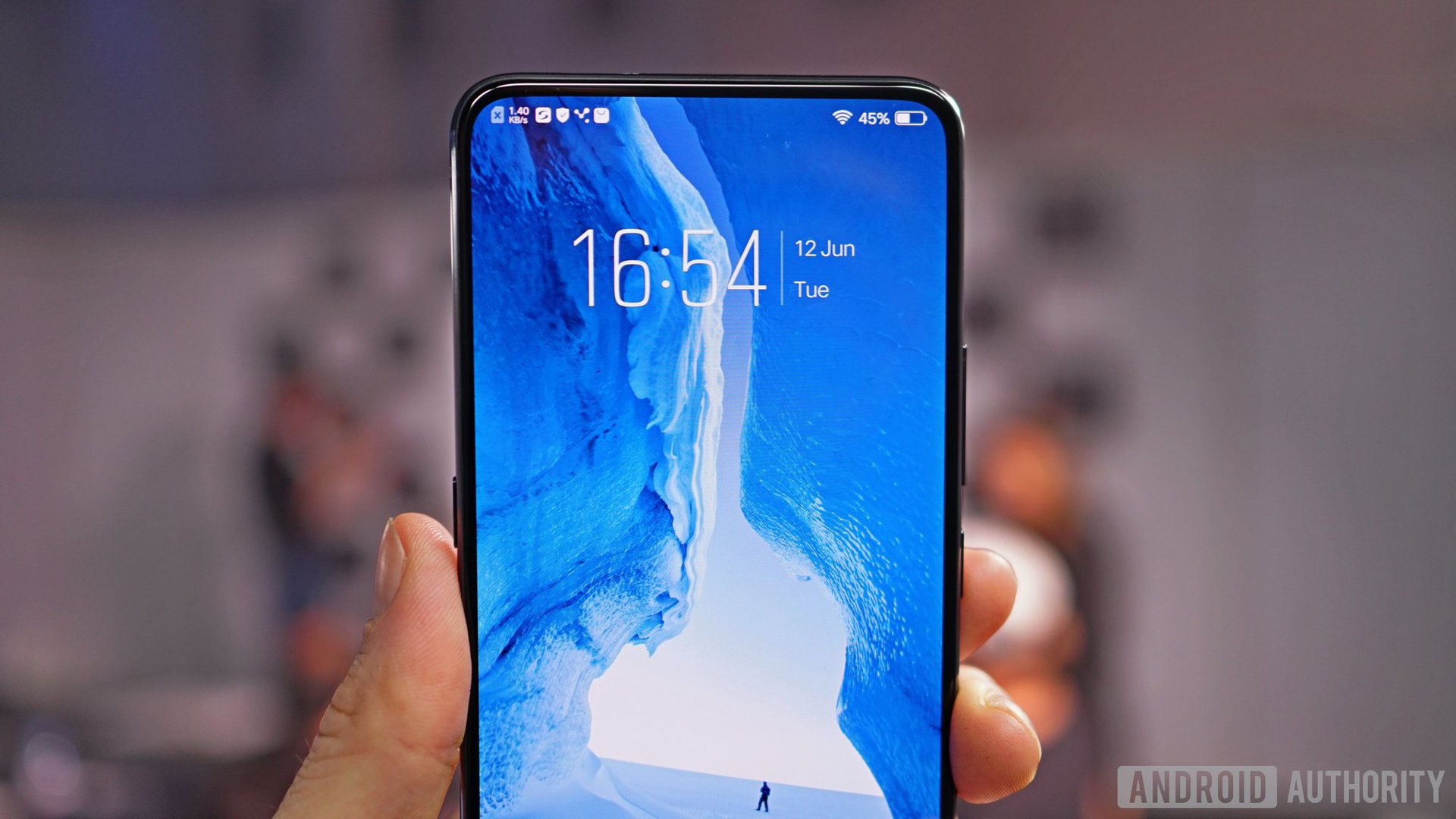
Vivo Nex
What we like
What we don't like
Vivo Nex
The day many of us have been waiting for has finally arrived. A truly bezel-free smartphone is here! Sort of. Many have tried and many have failed, with the much-maligned notch emerging as the compromised offspring of those failed attempts to rid the smartphone of bezels. The vivo Nex is the closest to a truly bezel-free smartphone we’ve seen come to market. It has very few compromises and no notch.
The phone fuses the in-display fingerprint scanner demo shown at CES 2018 and the drool-worthy Apex concept phone’s front-facing camera from MWC 2018, and we got to go hands on with it.
Availability
Unfortunately, the phone everyone wants — with a look long promised by science fiction — not everyone will be able to get. The vivo Nex is currently only slated for a Chinese release. It may come to other select markets in time, but a truly global release isn’t likely. Given HUAWEI and ZTE’s woes in the U.S., one can hardly blame vivo for focusing on more friendly markets. Selling units isn’t vivo’s main focus here though; demonstrating truly cutting-edge technology is.
Science fiction has long promised us that smartphones of the future would look like the vivo Nex.
If U.S. hostility to Chinese smartphones means the first bezel-free device you buy isn’t made by vivo, that’s perfectly fine. vivo says the Nex is more about taking a step into the industry’s future than it is about being number one. To that end, vivo senior vice president Alex Feng says he hopes the Nex gets the industry to “continue pondering ‘what’s next?’ in this mobile experience journey.”
For what it’s worth, I wish everyone would have a chance to buy the vivo Nex, because it truly feels like a momentous turning point. It feels somehow unfair that not everyone will get to experience such a significant device.
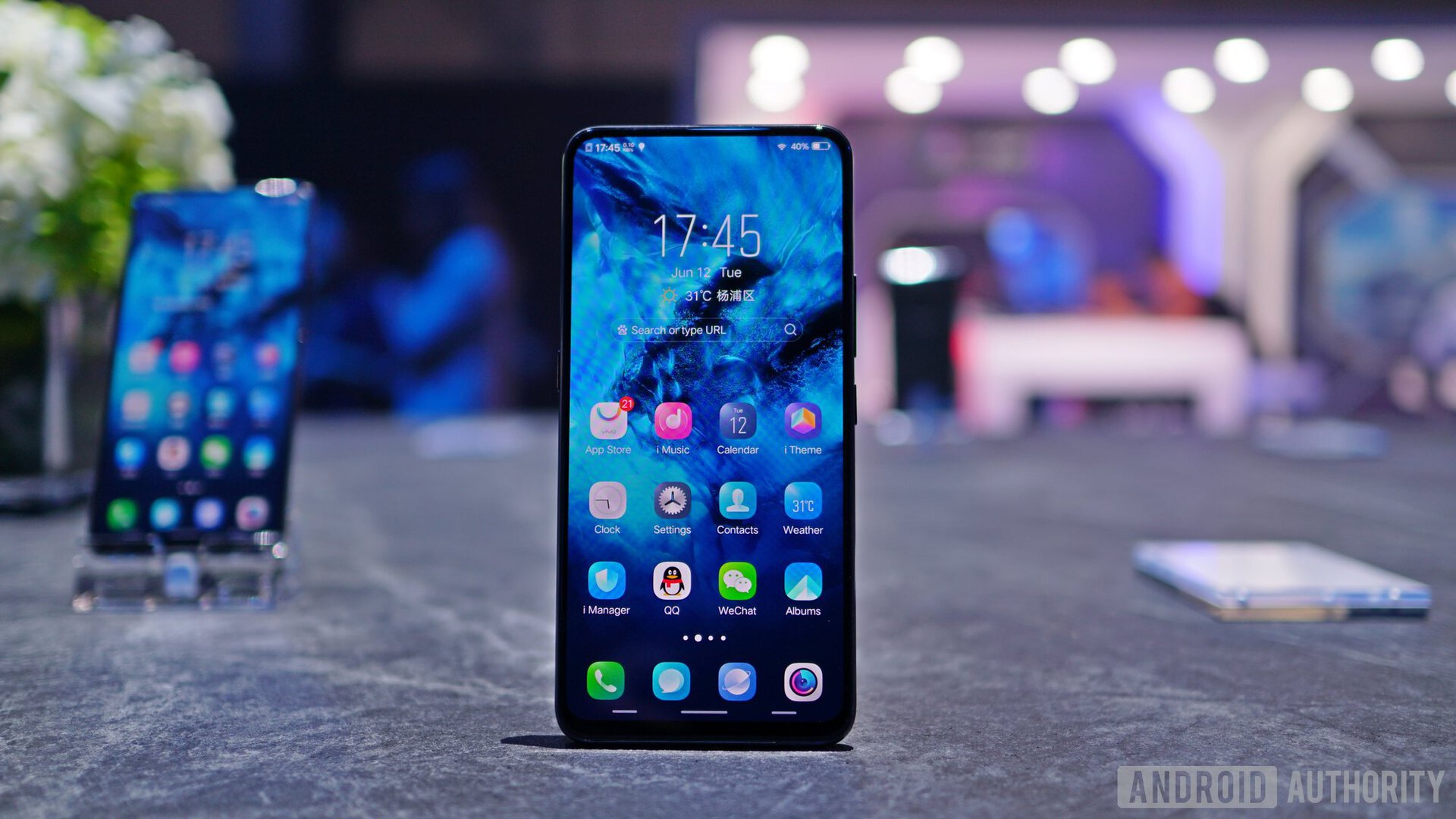
Display
As with most smartphones these days, it all starts with the screen. As bezels have shrunk, so too have the defining features on the front of most phones. The vivo Nex features a 6.59-inch Super AMOLED panel with a 19.3:9 aspect ratio and Full HD+ resolution (1,080 x 2,316, 338ppi). As with most other OLED panels, it offers deep blacks and colors that pop. There’s also an always-on display option for showing missed calls and message notifications.
The vivo Nex does away with the bezel above the display, only keeping a very slight chin at the bottom. In case you’re interested, the bezels measure 1.71 mm on the sides, 2.16mm on top and 5mm below the display. Because the vivo Nex pushes the boundaries with a 91.24 percent screen-to-body ratio, there’s no room for the usual array of sensors, cameras and speakers you’d find on a traditionally-proportioned smartphone. Those have now moved under the glass or inside the device’s body.
Audio
The earpiece speaker has been removed altogether. vivo’s Screen SoundCasting technology now use the display itself as a speaker. vivo says this not only releases the Nex from the burden of a top bezel but also adds “more powerful bass and softer, smoother treble.” From what I could hear at the noisy launch event it sounded fine, but we’ll give it some more rigorous testing in the full vivo Nex review. The rest of the Nex’s audio comes from a single bottom-firing speaker. There’s also a 3.5mm headphone port up top, in case you were worried.
The earpiece speaker and fingerprint scanner live under the display glass while the front-facing camera slides up from the top of the vivo Nex only when needed.
Fingerprint Scanner
The in-display fingerprint scanner is the other Big Deal in the vivo Nex. While the vivo X21 UD and Porsche Design HUAWEI Mate RS also featured such a scanner, vivo was the first to demo the tech back at CES 2018. The tech is now in its third generation, and while it won’t offer device unlocking quite as quick as a modern capacitive finger scanner, the slight delay you’ll experience will be far outweighed by the simple satisfaction of unlocking your phone through the screen. According to vivo, the new scanner provides a 10 percent speed increase, 50 percent higher accuracy and a 30 percent lower fake recognition rate than the under-glass scanners in previous devices.
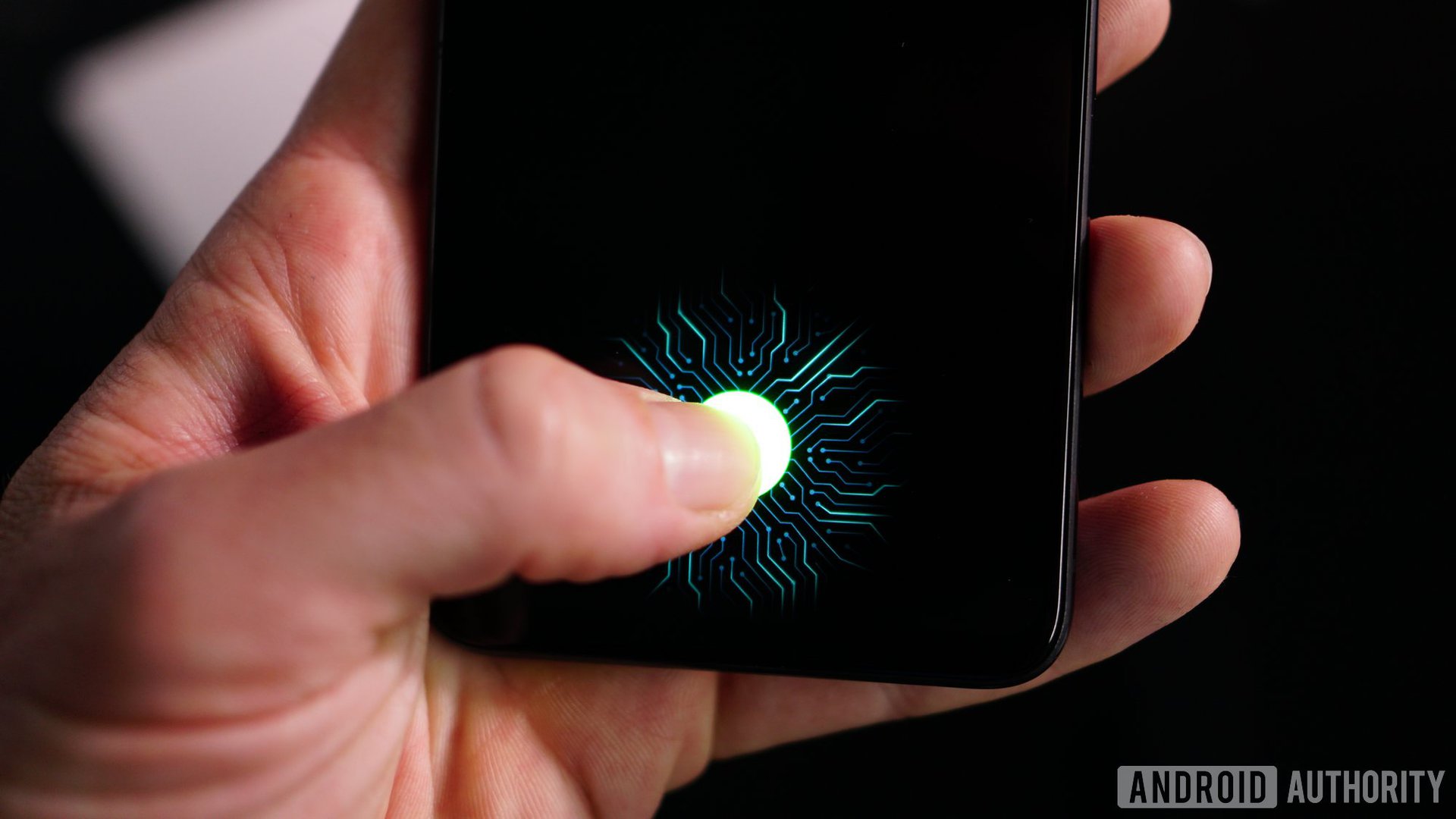
Cameras
The front-facing camera is hidden in the upper frame of the phone, popping up when you launch the front-facing camera. It’s a novel and, perhaps counterintuitively, kind of “obvious” solution to the bezel-free problem. Like OPPO’s rotating camera on the OPPO N1 or a plastic cover to obscure the webcam on your laptop, sometimes a simple solution is best. That said, I totally understand the misgivings many have aired over making the operation of your front-facing camera dependent on a piece of mechanical tech that could fail.
The camera mechanism has undergone extensive testing and can be raised and lowered 50,000 times and withstand up to 45kg of thrust force when extended.
To address the “failure question,” vivo assures me that the front-facing camera can push up to 500g in repeated trials and its micro-stepping motor, independent drive ICs and control algorithms allow the camera to move with absolute precision. With a special buffer structure design, the camera has also undergone reliability tests such as drop resistance and dust resistance tests. According to vivo, the camera can be raised and lowered repeatedly up to 50,000 times and withstand up to 45kg of thrust force when extended. Only time will tell what the failure rate of the camera elevator will be in real-world usage.
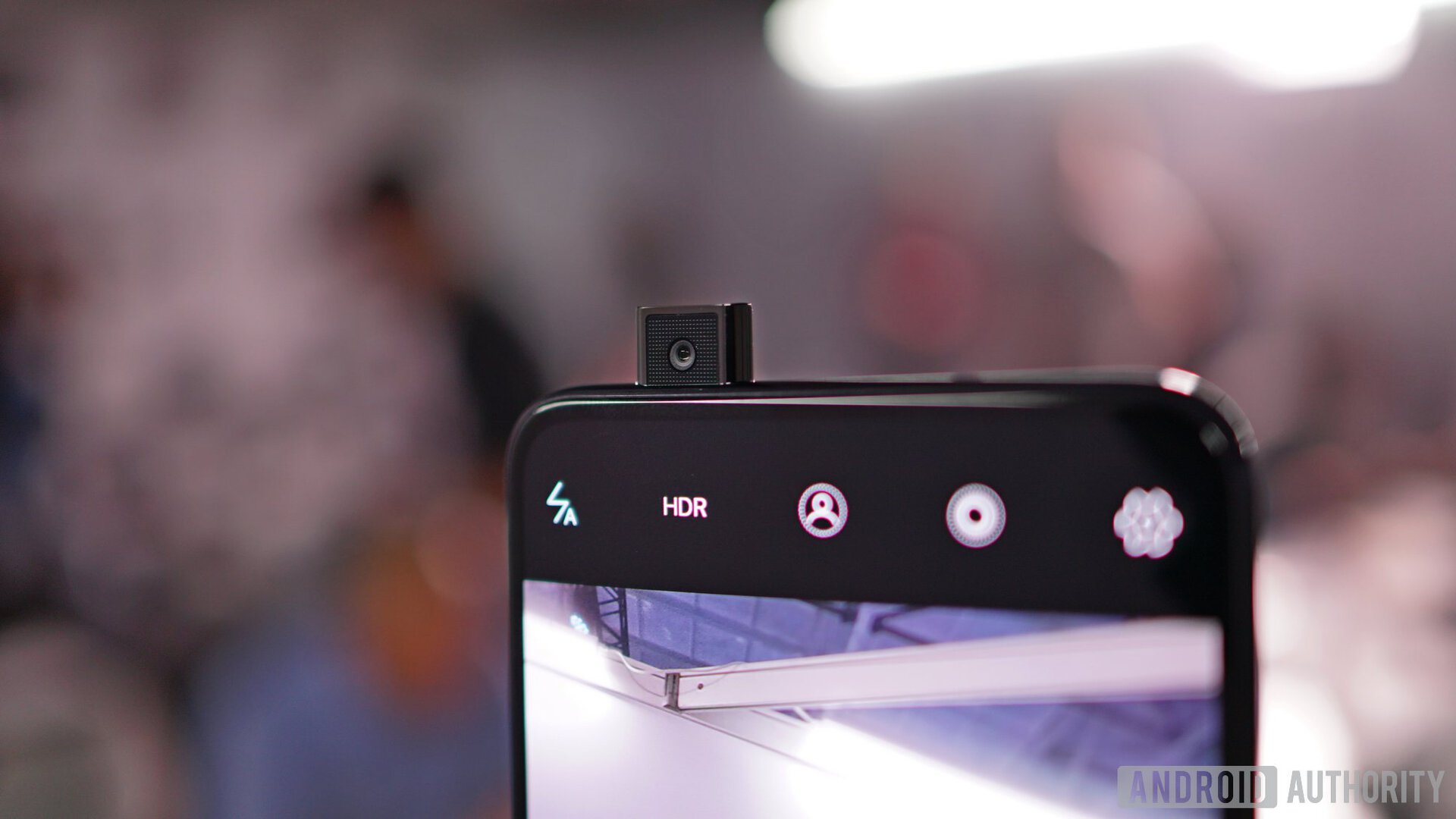
Speaking of cameras, the vivo Nex has a dual camera setup on the back. The camera has a 12MP f/1.8 sensor with 1.4-micron pixel size and both optical image stabilization and electronic image stabilization. The secondary camera on the back is a 5MP f/2.4 lens and the front-facing camera is an 8MP f/2.0 shooter. We didn’t have time for usable test shots at the launch event, but we can tell you shutter lag is a thing here. Stay tuned for a full gallery of images.
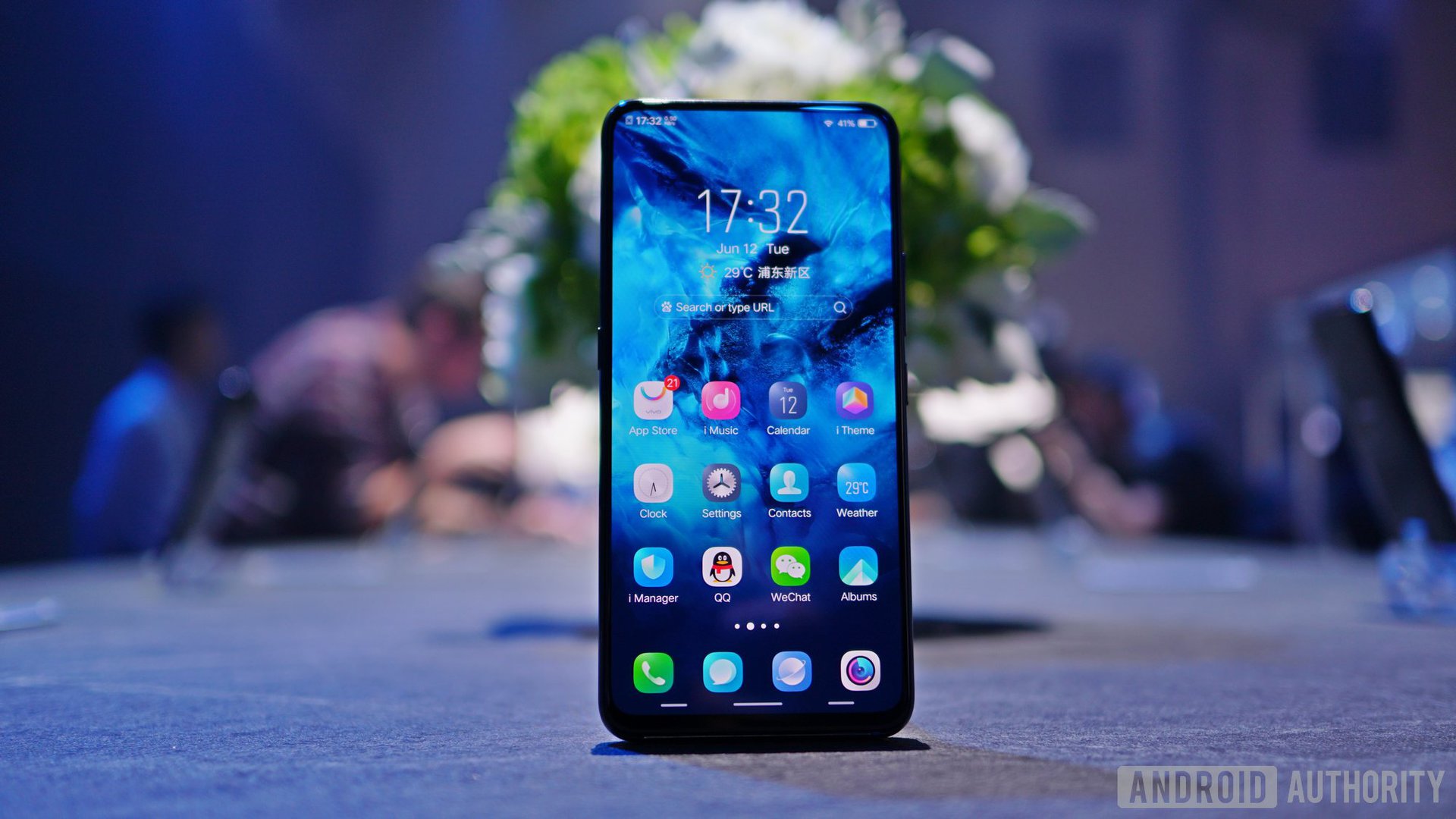
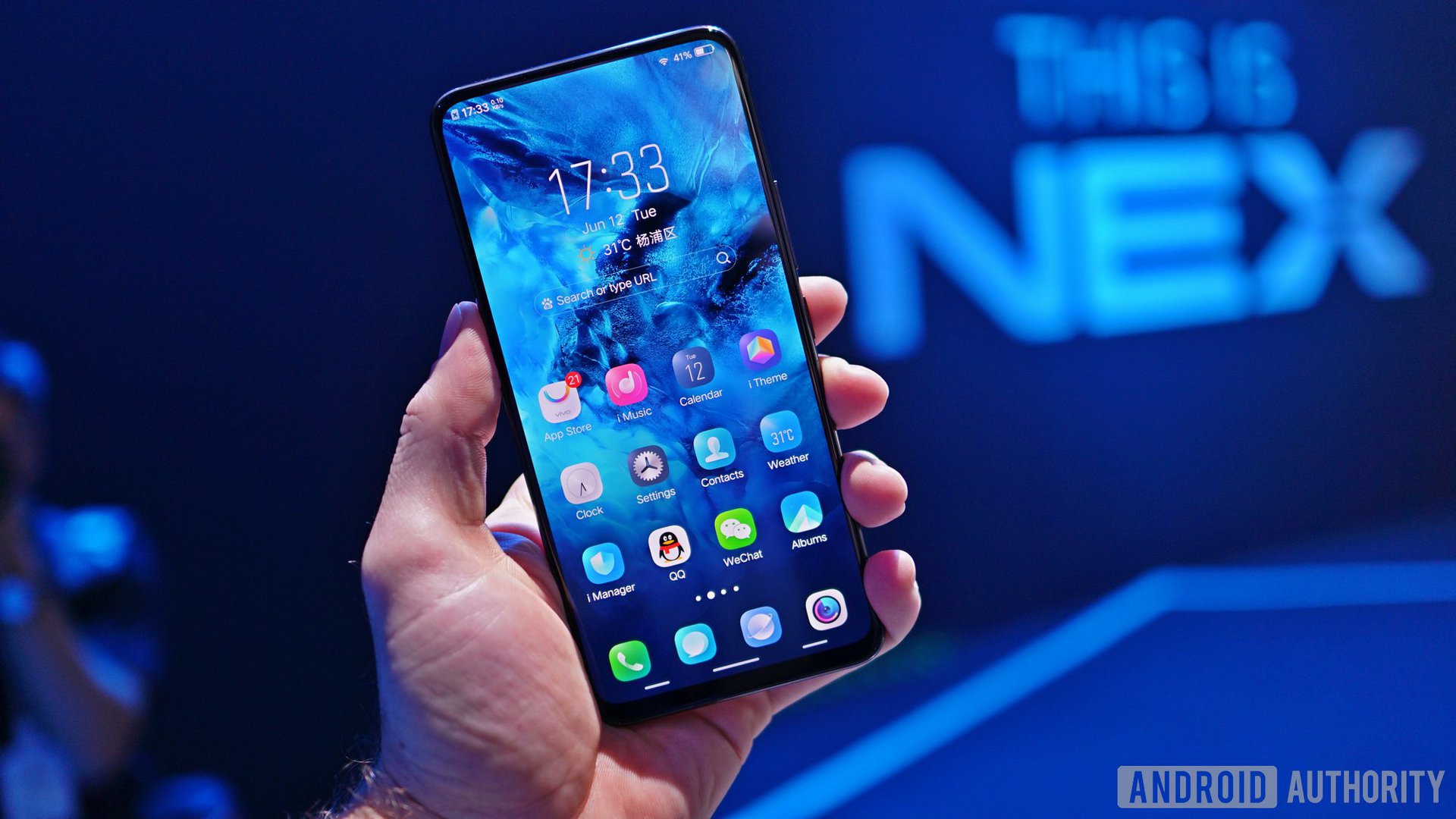
The camera app offers a range of aspect ratios and shutter triggers (including touch, voice, and a palm gesture). You can also reassign a long press of the volume down button to quickly launch the camera when the screen is off. If the last camera you were using was the front-facing one, the lens will slide up instantly while the camera app launches. There’s a full manual mode, HDR, portrait mode, and Live Photos. The front-facing camera only shoots 1080p video, but the main camera shoots 4K.
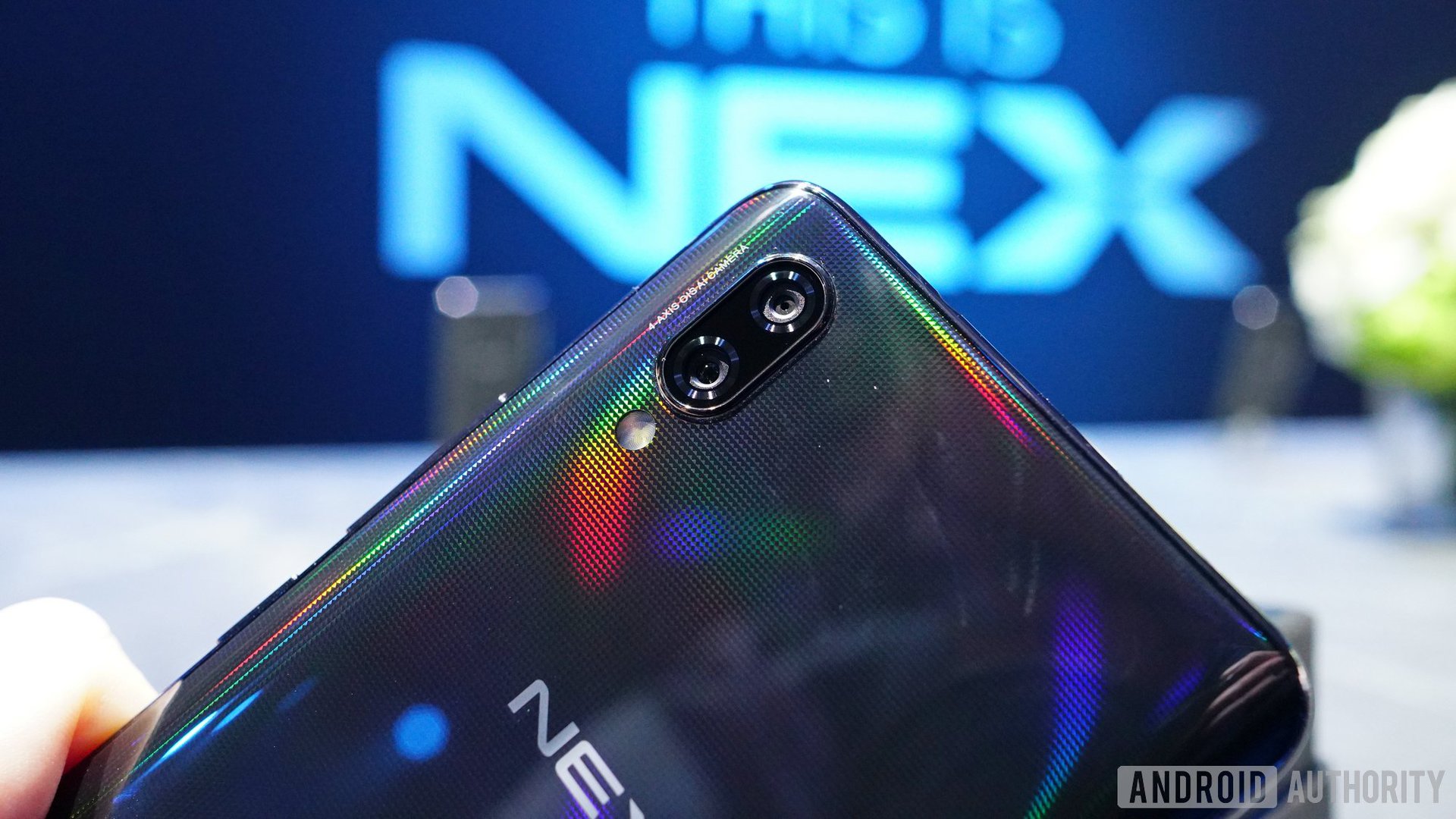
Features
The vivo Nex’s glass back features a nice diffracting pattern beneath the glass which creates rainbow colors in the right light. Despite the glass, the Nex lacks wireless charging, an IP rating, or NFC for contactless payment systems like Google Pay. The omission of any or all of these might be a dealbreaker for some.
As far as the rest of the phone goes though, there are no compromises. The vivo Nex packs in the Snapdragon 845 with Qualcomm’s AI Engine and the Adreno 630 GPU, 8GB of RAM, variants with 128 or 256GB of internal storage, a 4,000mAh battery with fast charging and Android 8.1 Oreo underneath vivo’s FunTouch 4.0 software layer.
| vivo Nex | |
|---|---|
Display | 6.59-inch Super AMOLED, Full HD+ (2316 x 1080, 338ppi), 19.3:9 aspect ratio |
SoC | Qualcomm Snapdragon 845 with AI Engine, 64-bit, octa-core, 10nm |
GPU | Adreno 630 |
RAM | 8GB |
Storage | 256GB |
Cameras | Rear: Dual pixel 12 MP f/1.8 (Sony IMX363) with 1.4µm pixel size, OIS and EIS + 5MP f/2.4 Front: 8MP, f/2.0 with elevating mechanism |
Audio | 32-bit/192kHz audio, 3.5mm audio jack |
Battery | 4,000 mAh, fast charging |
IP rating | No |
Sensors | Fingerprint (3rd generation in-display), accelerometer, proximity, compass, gyroscope, infrared, ambient light |
Network | GSM 850 / 900 / 1800 / 1900 CDMA 800 & TD-SCDMA HSDPA 850 / 900 / 1900 / 2100 LTE band 1(2100), 2(1900), 3(1800), 5(850), 8(900), 34(2000), 38(2600), 39(1900), 40(2300), 41(2500) |
Connectivity | Wi-Fi 802.11 a/b/g/n/ac, 2.4G/5.1G/5.8G, hotspot Bluetooth 5.0 A-GPS microUSB 2.0 3.5mm headphone port USB Type-C |
SIM | Dual SIM/hybrid slot |
Software | Android 8.1 Oreo Funtouch OS 4 |
Dimensions and weight | 162 x 77 x 7.98mm 199g |
The software experience on most Chinese phones won’t appeal to most westerners, but a quick dip into the pool of alternate Android launchers will manage to cure some of what ails you. We’ll dive deeper into what the software offers in the full vivo Nex review, but most of what you’d expect from an Android device is present and accounted for, it’s simply presented in a less palatable fashion than, say, the Pixel 2.
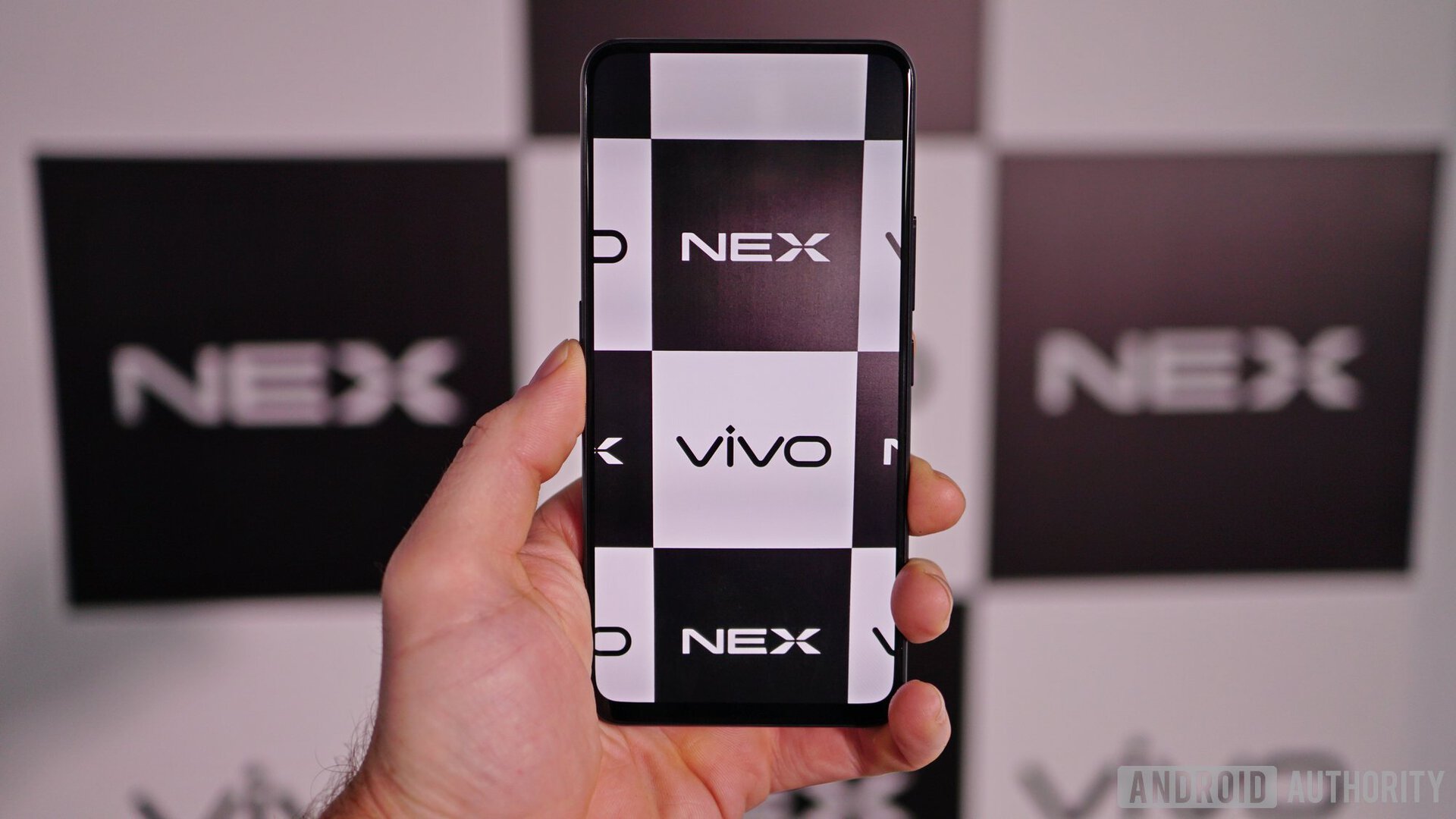
There’s a dedicated AI button on the left for summoning vivo’s Jovi Intelligent Voice Assistant. You can change what the button does in the settings, but only to the image recognizer, voice assistant, or nothing — there’s no option for switching it to your virtual assistant of choice. There’s also a ton of AI-this and AI-that, primarily in the camera. Most of this will probably not appeal and often doesn’t rely all that heavily on AI at all. We’ll cover that further in the review too.
Out of the box, the vivo Nex has gesture navigation turned on. Swipe up from one of three spots on the bottom of the screen to go back, go home or open recent apps. You can also turn on on-screen nav buttons if you prefer. vivo also lets you rearrange the order to put the back button (or back gesture) on the left side where it belongs. If you opt for gesture navigation and would like a visual cue, you can choose between horizontal lines or small dots. You can remove everything from the bottom of the screen once you’re used to it.
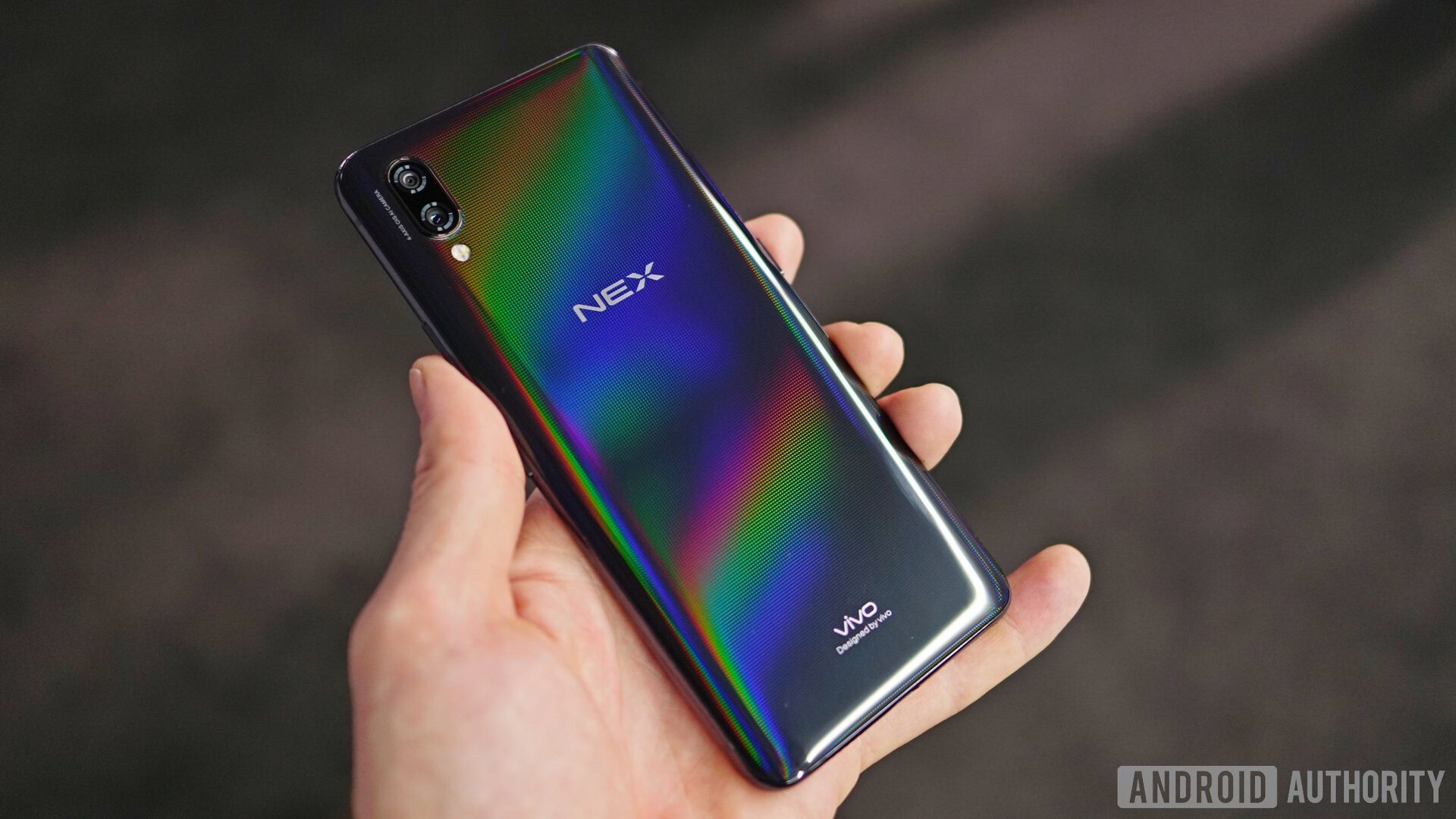
Conclusion
The vivo Nex will be available in China (and possibly other select markets in future). It’s priced at 4998 yuan (~$780) for the 256GB version, while the 128GB version will cost 4498 yuan (~$702).
Like its screen-to-body ratio, the vivo Nex comes very close to doing everything but falls slightly short. Even in my brief time with it, I noticed a few things that will niggle some people. Camera lag, a slow(ish) fingerprint scanner, bloatware, as well as the lack of an IP rating, NFC, and wireless charging are all worth noting. In all honesty, those absences are relatively minor, and frequently don’t appear on “normal” phones with big bezels and regularly placed fingerprint scanners.
Where the Nex fails, it more than makes up for in the sheer coolness, the novelty, the audacity of what it promises.
In some ways, the vivo Nex shouldn’t be considered a normal phone and shouldn’t be judged by the same standards. It goes somewhere no one else has gone before and it does so surprisingly well. However, it’s also a phone in the real world, affected by things like price, availability, update reliability, feature set and so on. It’s a first-gen product, to be sure, and as such we should expect a few things to not be quite perfect. Perhaps this is why vivo is more interested in showcasing tech with the Nex than it is in taking the world by storm.
The Nex more than makes up for its problems in sheer coolness, novelty, and the audacity of what it promises. We are literally on the brink of smartphones with all their traditional front-facing components and sensors hidden out of sight or underneath the display. The vivo Nex, even its name, points to a time so tantalizingly close we can almost touch it, even though it still hasn’t fully arrived.